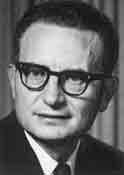Paul Samuelson
(1915 - 2009)

Paul Anthony Samuelson was born on May 15, 1915, in Gary, Indiana. He earned a bachelor’s degree of Arts from the University of Chicago in 1935, and a Ph.D. in Philosophy from Harvard University in 1941. After completing his studies, Samuelson became an Assistant Professor of economics at MIT, Associate Professor in 1944, and Professor in 1947. In 1947, he published his first major work, Foundations of Economic Analysis in which he demonstrated the integration of mathematics and that it was essential to understanding the fundamentals of economics. He was also the author of an influential economics textbook, Economics: An Introductory Analysis, first published in 1948, and revised regularly for the following fifty years.
Paul Samuelson is considered by many to be the founder of neoclassical economics. In welfare economics he helped to establish the criteria for deciding whether an action will improve welfare; these criteria came to be known as the Lindahl-Bowen-Samuelson condition. Samuelson is predominantly acknowledged for his public finance theory on determining the optimal allocation of resources in the presence of both public goods and private goods. Finally, Samuelson has influenced international economics through two important theories of international trade: the Balassa-Samuelson effect (consumer price levels are systematically higher in wealthier countries than in poor countries) and the Hecksher-Ohlin model (a General equilibrium mathematical model of the macroeconomy in international trade), in which the Stolper-Samuelson theorem (a basic theorem in trade theory which describes a relation between the relative prices of output goods and relative factor rewards) is utilized.
He was awarded the John Bates Clark Medal by the American Association of Economics in 1947, which is awarded to outstanding economists under the age of forty. Samuelson also received The Bank of Sweden Prize in Economic Sciences in 1970. Samuelson has served on many committees and honorary boards, including the National Resources Planning Board (1941-1943), United States Treasury (1945-1952), and the Council of Economic Affairs. He also was nominated as president of the American Association of Economics in 1961 and president of the International Economic Association in 1965.
Paul Samuelson was the first Jew to receive the Nobel Prize for Economics in 1970 for his contributions in numerous fields of economics. The following is an excerpt from the reasons for awarding Samuelson the Nobel Prize:
Generally speaking, Samuelson's contribution has been that, more than any other contemporary economist, he has contributed to raising the general analytical and methodological level in economic science. He has in fact simply rewritten considerable parts of economic theory. He has also shown the fundamental unity of both the problems and analytical techniques in economics, partly by a systematic application of the methodology of maximization for a broad set of problems. This means that Samuelson's contributions range over a large number of different fields.
Sources: Wikipedia; "Paul Sameulson Biography"; Cartage


